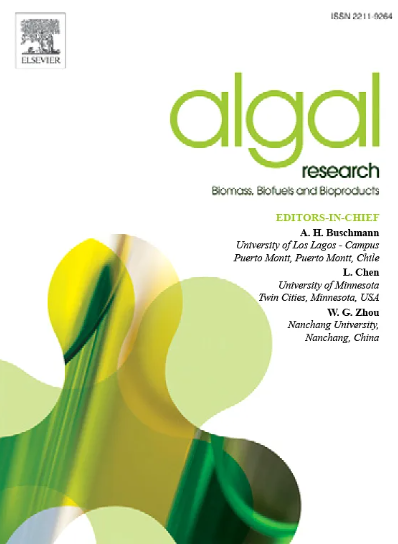Distribution patterns and benthic assemblages associated with Pyropia columbina, a harvested alga from the Atlantic Patagonian coast
IF 4.6
2区 生物学
Q1 BIOTECHNOLOGY & APPLIED MICROBIOLOGY
Algal Research-Biomass Biofuels and Bioproducts
Pub Date : 2025-03-20
DOI:10.1016/j.algal.2025.104014
引用次数: 0
Abstract
The benthic communities on rocky shores are shaped by a combination of biological, physical, and anthropogenic stressors. On Atlantic Patagonia's intertidal rocky shores, the seaweed Pyropia columbina plays an important ecological role and contributes economically to local communities. Despite its dominance in the benthic assemblage and the longstanding harvesting tradition, no previous studies have described changes in algae cover or the environmental factors shaping these patterns. Moreover, basic characteristics associated with the species have not been described in detail yet. The main objective of this study was to describe the populations of P. columbina along the Patagonian coast. Specific goals included evaluating the spatial and temporal distribution, abundance patterns of P. columbina and its associated benthic assemblages, and identifying the influence of environmental factors on these patterns. Additionally, we detailed the settlement substrates and attachment strength across different sites. Sampling was conducted at five locations on Patagonian coast, during two seasons (autumn and spring) over two years at the mid-intertidal level. Our results showed a greater cover of P. columbina in spring, related to its annual life cycle. Multivariate analyses of primary cover revealed similar assemblage structures across most sites. The main factors influencing the structure of benthic assemblages were wave exposure, rugosity, slope, maximum wave height, and suspended matter. Perumytilus purpuratus was the dominant species at most sites and the primary settlement substrate for P. columbina. The attachment strength of the algae was higher in spring and at sites with greater wave exposure, varying across different substrates. This study offers the first comprehensive description of the distribution patterns of P. columbina and its associated benthic communities on the rocky shores of Patagonia, providing valuable insights for the ecosystem-based management of these coastal areas.

求助全文
约1分钟内获得全文
求助全文
来源期刊

Algal Research-Biomass Biofuels and Bioproducts
BIOTECHNOLOGY & APPLIED MICROBIOLOGY-
CiteScore
9.40
自引率
7.80%
发文量
332
期刊介绍:
Algal Research is an international phycology journal covering all areas of emerging technologies in algae biology, biomass production, cultivation, harvesting, extraction, bioproducts, biorefinery, engineering, and econometrics. Algae is defined to include cyanobacteria, microalgae, and protists and symbionts of interest in biotechnology. The journal publishes original research and reviews for the following scope: algal biology, including but not exclusive to: phylogeny, biodiversity, molecular traits, metabolic regulation, and genetic engineering, algal cultivation, e.g. phototrophic systems, heterotrophic systems, and mixotrophic systems, algal harvesting and extraction systems, biotechnology to convert algal biomass and components into biofuels and bioproducts, e.g., nutraceuticals, pharmaceuticals, animal feed, plastics, etc. algal products and their economic assessment
 求助内容:
求助内容: 应助结果提醒方式:
应助结果提醒方式:


